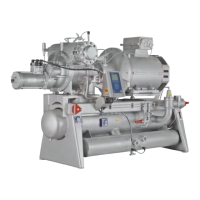Engineering manual - SAB 193-233-283 S A-frame (including ATEX)
142/175
008831 en 2022.02
Maintenance instructions
Condensing pressure
The terms “condensing pressure” or "high pressure", as used here, refer to the pressure at the
compressor outlet side. Usually the pressure is the same at the condenser inlet as at the com-
pressor outlet. The only difference is the pressure drop in the line.
Because of this pressure drop in the line, the pressure is a little higher at the compressor than
at the inlet to the condenser. The oil separator and stop valve mounted in the discharge line will
also contribute to the pressure drop.
Normal condensing pressure
In the condenser the absorbed heat energy in the refrigerant is released to the surroundings.
The heat energy in the refrigerant is the sum of the heat energy absorbed in the evaporator
and the energy supplied to the compressor via the electric motor taking the oil cooling system
into account.
During the condensing process, the refrigerant vapours are transformed into liquid again. To
give off the energy (heat) from the condenser, the temperature of the medium (air, water), to
which the heat is going to be transferred, must be lower than the condensing temperature.
Since there is a connection between the temperature and the pressure in the condenser, there
is a minimum value for how much the condensing temperature must fall. If the condensing
pressure level becomes too low, it will result in operational failures.

